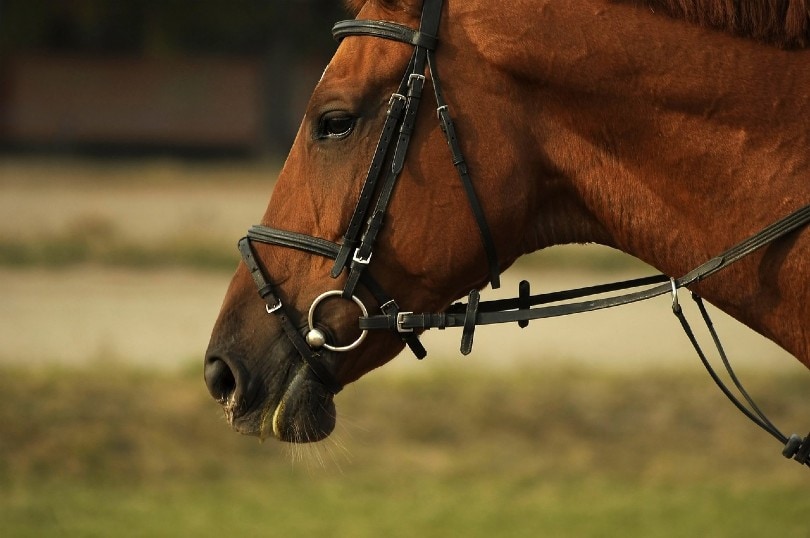There are entire books written about horse bits and how to find the best one for your horse, so it’s impossible to cover everything in a single article. That said, there are basics that every horse owner should know. To help simplify your search for the perfect horse bit, we have reviews of the most common bits in both English and Western disciplines, along with a few that cross over. We also look at what should factor into your choice of bit and how to find the best one for you and your horse.
A Quick Comparison of Our Favorites in 2024
| Image | Product | Details | ||
|---|---|---|---|---|
| Best Overall |

|
Horze Equestrian Copper Lozenge Link Eggbutt Snaffle Horse Bit |
|
Check Price |
| Best for Beginners |

|
Stübben Easy-Control Loose Ring Snaffle Horse Bit |
|
Check Price |
| Best for Barrel Racing |

|
JP Korsteel Blue Steel Oval Link Loose Ring Horse Snaffle Bit |
|
Check Price |
| Best for Training |

|
Weaver Leather Professional Ring Snaffle Bit |
|
Check Price |
| Best Correction Bit |

|
Professional's Choice Black Feather Shank Correction Bit |
|
Check Price |
The 10 Best Horse Bits
1. Horze Equestrian Copper Lozenge Link Eggbutt Snaffle Horse Bit — Best All-Purpose Bit
Every equestrian should have an all-purpose snaffle bit in their tack room. The best overall horse bit, Horze Equestrian Copper Lozenge Link Eggbutt Snaffle Horse Bit, is a three-piece snaffle that comes in various mouth sizes, ranging from 4.5 to 5.75 inches. The three-piece style makes this bit super gentle. It’s a great bit for everyday riding, safe in the hands of inexperienced riders, and useful in both Western and English disciplines. The copper mouthpiece promotes salivation in your horse, so they won’t become uncomfortable wearing this bit for long periods of time.
The eggbutt-style cheekpieces on this snaffle bit mean you won’t need bit guards like you would with a loose ring snaffle bit. The one downside of having an eggbutt snaffle is that the bit must fit your horse’s mouth perfectly. If you’re switching between different horses, you may be better off with a loose-ring snaffle. While a three-piece bit is generally milder on a horse’s mouth than a two-piece, single-break snaffle, some horses simply don’t like it. This bit is also quite gentle, so it’s not ideal for training.
2. Stübben Easy-Control Loose Ring Snaffle Horse Bit — Best for Beginners
The Stübben Easy-Control Loose Ring Snaffle Horse Bit is a relatively mild bit that’s safe enough for beginners to use but also makes a great training bit. With the mouthpiece separated from the rings, your horse will be able to feel even the subtlest of rein cues. Since it’s a snaffle, it operates on direct rein pressure, and the double break mouthpiece makes it gentler than a bit with a single break.
As with any bit, this one can become harsh if it’s operated by a heavy-handed rider or beginner horse riders who don’t have good rein control. If heavy-handedness is a concern, riders should opt for riding in a halter or side-pull bitless bridle to avoid causing damage to their horse’s mouth.
3. JP Korsteel Blue Steel Oval Link Loose Ring Horse Snaffle Bit — Best for Barrel Racing
The JP Korsteel Blue Steel Oval Link Loose Ring Horse Snaffle Bit is a great choice of bit for barrel racing. The curved design reduces nutcracker action by preventing contact with your horse’s mouth, while the steel finish promotes salivation.
The mobile design of this snaffle helps prevent your horse from leaning on their forehand, which is particularly important in barrel racing. By getting your horse to work from their hind end, you will have more power and speed on the pattern.
4. Weaver Leather Professional Ring Snaffle Bit — Best for Training
The Weaver Leather Professional Ring Snaffle Bit has a loose ring design to help your horse pick up subtle reining cues. Since it’s a loose ring, it will need bit guards on the side to protect your horse’s lips. This is a relatively mild, functional bit with a single break. It should be noted that a twisted wire bit is harsher than a smooth bit and shouldn’t be used by beginners.
This is a good choice for horses that need slightly stronger communication than a typical snaffle but don’t require the extra leverage of a shank. This bit can become rusty in the long term, so it will need regular cleaning.
5. Professional’s Choice Black Feather Shank Correction Bit — Best Correction Bit
The Professional’s Choice Black Feather Shank Correction Bit is a curb bit designed for the exact exercise that it’s named for: correction. Such bits play an important role in training. This port bit contains copper to promote salivation and shanks that swivel to refine communication.
This bit, or some version of it, is likely to be found in the tack room arsenal of most trainers. It’s a popular bit style because it works so well and can be used on almost any horse to refine and soften cues. It’s also a great choice for transitioning young horses from a snaffle to a curb bit.
This bit will be harsh if it is placed in inexperienced hands. A bit is only as good as the rider’s skill, so while this is a great choice for experienced horse riders, it should not be used by beginners.
6. Professional’s Choice Bob Avila Santa Rosa Shank — Best Western Show Bit
Many Western shows don’t allow competitors to use snaffle bits in the show ring for horses over the age of 5. In most cases, show bits are meant to be used when riding one-handed, so little direct rein pressure should be applied to the long shanks.
The Professional’s Choice Bob Avila Santa Rosa Shank has a copper roller mouthpiece for impatient horses to fiddle with while also promoting salivation. As with any “show bit,” this one isn’t designed for daily riding but will mostly be reserved for use in the ring.
7. Myler 02 English Dee Without Hooks — Best Hunter/Jumper/Dressage Bit
The Myler 02 English Dee Without Hooks bit is dressage legal and multi-purpose for all English disciplines. Myler bits have different levels that correspond to your horse’s personality, training, potential, and experience. Level-one bits operate using mainly tongue pressure and are considered the mildest of all Myler bits. The centerpiece of this bit rotates separately to encourage your horse to break at the poll without pinching, while the curved mouthpiece provides your horse with a more comfortable fit.
This bit does not have hooks on it, so there is no separate place to secure the bit to the bridle. This can result in less stability of the bit in the horse’s mouth. Whether this is an issue is a matter of preference. Hooks are specific to English disciplines; while Western horses can use D-ring snaffle bits, they don’t typically have hooks on them.
8. HORZE Apple Flavor Mullen Mouth Loose Ring Snaffle Bit — Best for Colt Starting and Green
The HORZE Apple Flavor Mullen Mouth Loose Ring Snaffle Bit is apple flavored to encourage sensitive or green horses to take the bit. The Mullen-style mouthpiece gives the bit stability, while the rubber, flavored coating encourages acceptance of the bit in a positive manner. The solid mouthpiece won’t collapse with pressure, and the pressure is evenly distributed across the horse’s mouth. Loose cheekpieces promote self-carriage.
This bit is ideal for starting horses because it has built-in positive reinforcement mechanisms to encourage bit acceptance for those that may be reluctant to do so. It’s not great for long-term use or refinement of movement. However, it provides an extra bit of help and encouragement for a horse that needs it.
9. Reinsman 349 Junior Cowhorse Snaffle — Best for Horses That Don’t Go in a Snaffle or That Work Cattle
Junior cowhorse bits come in different styles, but they are essentially three-piece gag bits with short shanks. Some are “half-gags” with leverage. The Reinsman 349 Junior Cowhorse Snaffle is designed to help your horse move from direct reining to neck reining. It helps in teaching your horse to get their legs underneath themselves and their hind end down—the exact movements that you desire when working a cow.
While this bit is dubbed as a “cowhorse” bit, it’s a fantastic bit for horses that need more contact than a snaffle provides. The roller often pacifies nervous horses and encourages proper headset by adding tongue pressure. This bit is also a sweet iron bit, so it tastes good to your horse.
Junior cowhorse bits fall in the “love them” or “hate them” category in the horse world. Some horses go well in them and some don’t. Since it is a curb bit, it can be harsh if used by heavy-handed riders. This model is a nice in-between gag bit with some leverage.
10. The Bob Avila Collection by Professionals Choice Port With Roller Bit
Swiveled port bits like The Bob Avila Collection by Professionals Choice Port With Roller Bit are mild shank bits when used with light hands. The mouthpiece is designed to rotate a full 360 degrees, and each side rotates separately, giving you the ultimate control over each part of your horse’s body. You can find this type of bit with all different shank lengths, fancy show designs, or plain sides, but what ultimately matters is how you use it for cueing your horse.
Swivel action makes rein cues extremely simple for your horse to understand, which makes this bit a great tool when transitioning a young horse from a snaffle to a curb. This bit can still be used with direct reining, mimicking snaffle bit pressure and enabling your horse to adjust with almost no difficulty. This bit has a long shank, which is ideal for slowing down the connection between the rider’s hands and the horse’s mouth. This is essential for your horse to learn to go in a leverage bit.
Buyer’s Guide — Horse Bits 101
Horse bits are among the most misunderstood, mislabeled, and misused pieces of horse tack in existence. Snaffle, curb, leverage, gag, port, shank, loose ring—while these terms are tossed around freely among horse people, they can be incredibly confusing for anyone just learning about bits. For all intents and purposes, there are two primary bit types:
There are thousands of different variations of each, but every horse bit will fall into one of these categories. The distinction is important. It is a common misperception that a snaffle bit refers to any bit with a break in the mouthpiece. There are even bits that are named snaffles (like the Tom Thumb Snaffle) that have shanks but are, in fact, curb bits.
Snaffle bits work on direct pressure, while curb bits work on leverage. If a bit has shanks and runs on leverage, it’s a curb bit. The mouthpiece doesn’t have anything to do with it. Many snaffles and curbs have identical mouthpieces but operate completely differently. The cheekpiece defines the bit and nothing else.
Types of Snaffles
Snaffle bits come in all different types, including D-rings, O rings, eggbutts, loose rings, fixed rings, and full cheeks. They can also have any type of mouthpiece:
Types of Curb Bits
Curb bits can have any of the listed mouthpieces and about a dozen others. The mouthpiece doesn’t matter, the cheekpiece does! Curb bits can have long shanks or short and all different styles, but they always have shanks that connect the bit to the rein. The shank acts as a lever when rein pressure is applied. The horse will receive pressure from the curb strap under their chin, and then the pressure will be applied to different parts of the horse’s mouth, depending on the type of mouthpiece.
English Bit Exceptions
While all bits can be classified as either snaffles or curbs, three types of English bits operate as an “in-between” category. The Pelham, Kimberwicke, and Elevator bits can operate with the characteristics of a snaffle and a curb. Pelham and Elevator bits are used with double reins, so one set of reins runs on a snaffle ring while the other runs on the curb ring. This enables the rider to use either type of bit action as they see fit.
How to Choose the Best Horse Bit
The wide variety of horse bits available means there is one suit for every different combination of horse, rider, goal, and discipline. Even small differences in bit construction can affect the way that a horse responds to rein aids.

Your Hands
A rider’s hands should move independently of the rest of the body. This means the rider should be balanced in the saddle and not put pressure on the reins to balance themselves. While riding, your hands can move up, down, and to the side. If you don’t yet have independent hands, you should only use gentle bits while learning, to avoid causing pain to your horse.
Your Horse’s Mouth
Some horses are more sensitive to rein pressure than others. They are often referred to as “soft-mouthed” or “hard-mouthed” horses. Young or green horses have sensitive mouths and require gentle bits in combination with gentle hands. Horses that have been ridden rough and in harsh bits often have hard mouths. They require desensitization and often don’t respond to gentle bits or light rein aids.
Training Issues
If you have specific training issues with your horse that you want to address, this will affect your choice of bit. The ultimate goal should always be to have a responsive horse in the gentlest bit possible, but sometimes, different bits can help overcome challenges in your horse’s learning. For example, if your horse doesn’t stop well, you may have to use a more powerful bit to train your horse’s stop with light aids. It’s important to note that a training bit should be used as a tool. Horses shouldn’t be “bitted up” in an effort to mask an issue that can be solved with the appropriate training.
Riding Discipline
The riding discipline that you participate in will play a part in your choice of bit. Hunters, jumpers, dressage, Western pleasure, reining, and cutting competitions have rules surrounding what bits you are allowed to use in the ring. In a Western pleasure show, for example, you can only use a snaffle bit on a horse that is 5 years old or under. If your horse is older than that, you must ride them in a curb bit, but it can’t be a gag bit, like the junior cowhorse.

Are Bits Cruel?
This question is worth addressing because there are people who don’t use bits on horses or feel that bits are painful torture devices that damage horses’ mouths.
The goal of a bit is to enhance the level of communication between the rider and the horse in a gentle way. If used correctly by compassionate and gentle riders and trainers, they are not cruel by themselves.
Regardless of the bit that you use, it does make contact with and adds pressure to a sensitive part of the horse’s body. If the rider on the end of the reins yanks, pulls, or otherwise uses the aid in an unpleasant way, even the mildest of bits can cause pain. Like any other tool in horse training, bits operate on the principle of pressure and release. It might be uncomfortable enough to elicit a response, but it should never cause pain when used correctly.
How to Measure for a Bit
The most common bit sizes are 5, 5.5, and 6 inches. Some bits come in 6.5- and 7-inch sizes and are primarily used for draft or draft cross horses. Bits under 5 inches in length are considered pony bits.
A bit is measured by laying it flat and using a ruler to measure the space between the cheekpieces.
You can use a bit sizer to help you measure your horse’s mouth for a bit. It’s important to get the right size because a bit that’s too small will pinch the corners of your horse’s mouth, and a too-large bit won’t be effective in communicating your rein aids.
Conclusion
Ultimately, the best horse bit is the mildest one that you can use to communicate with your horse. Like people, horses have preferences regarding bits. Sometimes it takes a bit of trial and error to find the one that you need. Like the Horze Equestrian Copper Lozenge Link Eggbutt Snaffle Horse Bit, a snaffle bit is a good all-around horse bit that can be used in many different disciplines and for everyday riding. If you want something more geared toward beginners, the Stübben Easy-Control Loose Ring Snaffle Horse Bit is an excellent choice.
The reviews in this article should give you a good starting point on what to look for. When in doubt, try different options, or consult a trainer for help choosing the best bit for you and your horse.
Featured Image Credit: 11A Fotografie, Shutterstock






















